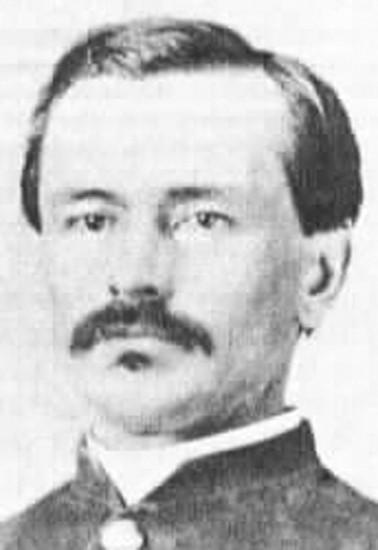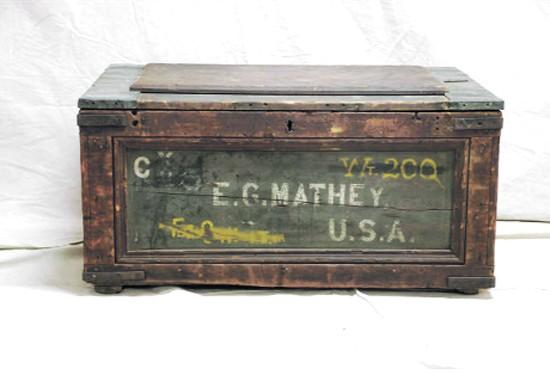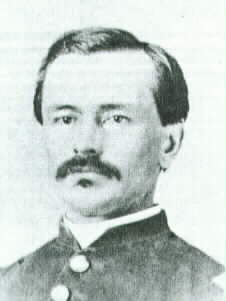In command of pack train and involved in hilltop fighting at the Battle of the Little Big Horn.
Born October 27, 1837, in France, he enlisted from Indiana as a Private, 17th Indiana Volunteer Infantry, in June 1861 and was promoted to Sergeant, Company C, to rank from May 31, 1861. Appointed Second Lieutenant in the same regiment effective May 1, 1862. On August 10, 1862, he resigned and was appointed a Second Lieutenant in the 81st Indiana Volunteer Infantry to rank from September 1, 1862. He fought with this regiment during the rest of Civil War and was engaged in the battle of Chickamauga. Promoted to First Lieutenant effective March 21, 1863, and to Captain on November 8, 1863. He participated in the demonstration before Rocky Faced Ridge, the battle of Resaca, the action near Kingston, the Battle of Kenesaw Mountain, the action at Marietta and the siege of Atlanta. He was engaged in the battle of Jonesborough, the action at Lovejoy Station, the battle at Franklin and the battle of Nashville. Promoted to Major effective September 12, 1864. Mustered out of the volunteer service June 13, 1865.
Appointed Second Lieutenant, 7th United States Cavalry, to rank from September 24, 1867, and promoted to First Lieutenant May 10, 1870. On May 17, 1876, he departed with 7th Cavalry to participate in the Sioux expedition. From June 22 he commanded the pack train accompanying the 7th Cavalry and on June 25-26 he was in the hilltop fight on the Little Big Horn River. He returned to Fort Lincoln September 26. Engaged in the 1877 campaign against Chief Joseph's band of Nez Perce. Promoted to Captain to rank from September 30, 1877, after the Snake Creed fight near the Bear Paw Mountains.
On December 11, 1896, he retired with the rank of Major for disability incurred in the line of duty and was promoted to Lieutenant Colonel, United States Army, retired, on April 23, 1904. Died July 17, 1915 at Mercy Hospital, Denver, Colorado, in his 78th year.
Interred in the National Cemetery at Arlington, Virginia, Section 3, Grave 2089. Survived by his invalid wife, Meda Jones, and his daughter, Julia P. Mathey.
Custer officer's well-traveled trunk headed to auction block
Courtesy of The Billings (Montana) Gazette
Lieutenant Colonel Edward Gustav Mathey was in at the formation of the U.S. 7th Cavalry in Fort Riley, Kansas, in the aftermath of the Civil War, and he stayed with the regiment through the Battle of the Little Bighorn and the Battle of the Bear Paws in a long career that took him all over the American West.
And everywhere he went, the handmade wooden trunk that stored his earthly goods went with him. Today, that trunk, still bearing his name and those of the numerous forts where he was posted in nearly 30 years of service, will be auctioned in New Braunfels, Texas.
“It could go for anywhere from $4,000 to $10,000,” said Dave Higginbotham of Conroe, Texas, who authenticated the trunk for Burley Auction Gallery. “It really depends on what it might be worth to someone. I think it's a national treasure.”
There is no minimum bid, auctioneer Robb Burley said from New Braunfels. “We know it's going to sell,” he said.
Burley said he could not identify the trunk's owner but said that it was no longer in the Mathey family.
Higginbotham said that about a year ago, the owner had spotted the trunk at an antique store in Tennessee – a long way from Denver, where Mathey died July 17, 1915, at the age of 78. Mathey is buried in Arlington National Cemetery. He was survived by a wife and daughter.
John Doerner, chief historian at Little Bighorn Battlefield National Monument, said he didn't know that Mathey's trunk was still around, but he said he's not surprised.
“It's amazing what's out there,” he said. “It would be nice if there was a foundation that could buy these things when they come up suddenly like that. It would be great to have the trunk here or at Fort Lincoln.”
Fort Lincoln, near Bismarck, North Dakota, is where the 7th Cavalry marched from on its way to Montana in the spring of 1876. Lieutenant Colonel George Custer was in the column. Mathey, a Civil War veteran, was a First Lieutenant then.
“Most of the time, things like this go into a private collector's vault,” Doerner said. “A lot of people buy this stuff as an investment. It'll probably be on sale again in 10 years.”
None of Mathey's personal possessions remain in the trunk, but his name is stenciled in white paint across the front.
“They were personal property,” Doerner said. “They got banged around a lot and shipped all over the country.”
Every time the officer moved to a new assignment, the name of the fort was painted on the trunk, Higginbotham said.
“When they moved to a new destination, they just painted through the name of the old one,” he said. “With extreme difficulty, we were able to make out the names of the forts.”
He also found tacks and remnants of placards that had probably been used to identify destinations once the wood itself had become too crowded with the painted names.
Mathey isn't a figure recognized much outside Little Bighorn historians. He didn't play a major role as did Custer, Crazy Horse, Sitting Bull or Custer's top officers, Major Marcus Reno and Captain Frederick Benteen.
But Higginbotham, who has studied the battle for decades, thought the name rang a bell.
“I went through some books and materials and found him,” the historian said.
He grew more excited as he studied the trunk and the names of the forts he was able to decipher.
“It was just such a thrill to touch something like that,” he said. “It belonged to someone who was instrumental in taming the West.”
On the day of the Little Bighorn, June 25, 1876, Mathey, the Company M lieutenant, was in charge of the pack train that carried ammunition and supplies for the troop. He survived on a bluff above the Little Bighorn River where Sioux and Cheyenne warriors held troops under the command of Reno and Benteen under siege for two days. Custer, who had divided his command just before the battle, and his troops were wiped out a few miles away.
Mathey clearly had not impressed Benteen, his superior officer. The captain wrote in a letter in 1891, “I don't suppose there was ever an officer of the army got such a ‘cussing out' as I gave Mathey at the Little Bighorn on the eve of June 25th, and before crowds of enlisted men, officers and packs.”
The next year found Mathey back in the saddle and back in Montana for the Nez Perce War of 1877. He was among the troops who accepted the surrender of Chief Joseph at the Bear Paw Battle, fought south of what is now Chinook.
He retired from the Army with a disability, apparently the result of a wound in the line of duty, in 1896.
Mathey was renowned among the troops for his foul mouth and was dubbed by them “Bible Thumper.”
His trunk was well-made, with wrought-iron straps and a zinc top, Higginbotham said.
Photo Courtesy of Richard Tilford
Edward Gustave Mathey of France
Appointed from Indiana, First Sergeant, Company C, 17th Indiana Volunteer Infantry, 31 May 1861
Second Lieutenant, 1 May 1862
Resigned 10 August 1862
Second Lieutenant, 81st Indiana Volunteer Infantry, September 1862
First Lieutenant, 21 March 1863
Captain, 8 November 1863
Major, 12 September 1864
Honorably mustered out on 13 June 1865
Second Lieutenant, 7th U. S. Cavalry, 24 September 1867
First Lieutenant, 10 May 1870
Captain, 30 September 1877
Retired with the rank of Major, 11 December 1896
MATHEY, EDWARD G
LT COL USA RET
DATE OF DEATH: 07/17/1915
BURIED AT: SECTION SD WS SITE 2089
ARLINGTON NATIONAL CEMETERY
MATHEY, JULIA D/O EDWARD G
DATE OF DEATH: 12/11/1946
BURIED AT: SECTION SOUTH SITE 2089
ARLINGTON NATIONAL CEMETERY
MATHEY, MEDA J W/O EDW B
DATE OF DEATH: 02/19/1917
BURIED AT: SECTION S DIV SITE 2089
ARLINGTON NATIONAL CEMETERY
Michael Robert Patterson was born in Arlington and is the son of a former officer of the US Army. So it was no wonder that sooner or later his interests drew him to American history and especially to American military history. Many of his articles can be found on renowned portals like the New York Times, Washingtonpost or Wikipedia.
Reviewed by: Michael Howard



